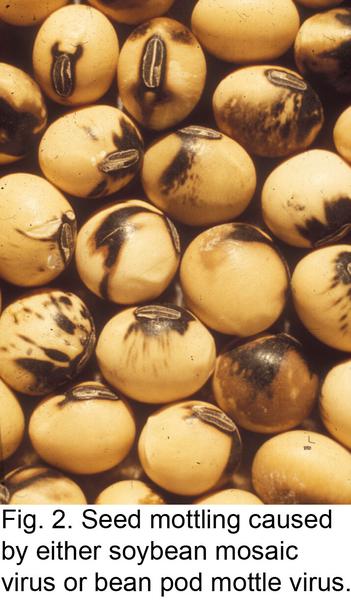Soybean Mosaic Virus
- Type
- Disease
- Leaf Condition
- Distorted, Brittle, Leaf Spot
- Leaf Location
- Upper, Lower, Young, Mature
- Plant Size
- Stunted
- Field Distribution
- Random, Localized Area
- Prior Environmental
- Cool Cloudy
- Season
- Early Vegetative, Mid To Late Vegetative, Flowering, Pods Present, Post Harvest
- Cropping System
- Soybean Followed By Soybean, Conventional Till, Reduced Till
Introduction
Soybean mosaic virus (SMV) was first reported affecting soybean (Glycine max L.) in 1915 in Connecticut, but currently is one of the most prevalent and destructive viral pathogens of soybean worldwide. SMV can cause yield losses ranging from 8 - 35%, but yield losses as high as 94% have been reported. Similarly to bean pod mottle virus (BPMV), SMV predisposes soybeans to infections by Phomopsis spp. In North Carolina, SMV is rarely observed, but may occasionally be observed in local areas.
Pathogen
Soybean mosaic is caused by the single-stranded positive-sense RNA soybean mosaic virus (SMV). SMV is a member of the genus Potyvirus in the family Potyviridae. In the United States, seven distinct strains (G1 – G7) have been identified based on their differential interactions with susceptible and resistant soybean varieties. Viruses cannot be observed with the naked eye, and positive identification requires lab testing.
Host Range
Soybean is the most economically important host for SMV. SMV has also been reported affecting members of six plant families including, Fabaceae, Amaranthaceae, Chenopodiaceae, and Solanaceae.
Symptoms
SMV symptoms vary across host genotype, virus strain, and the plant growth stage when infected. In general, symptoms are less severe at temperatures ranging from 24 - 25°C, but may not be apparent at temperatures higher than 30°C. Symptoms can often be confused with herbicide injury, and chemical injuries should be ruled out.
Common symptoms include, trifoliolate leaves with a light and dark green mosaic, chlorosis between dark green areas, and leaf curled downward (Figure 1). Stunting, systemic necrosis, and defoliation may be observed, depending on the virus strain. Seeds of affected plants may also have mottling symptoms that can be attributed to SMV or bean pod mottle virus (Figure 2). Since SMV is caused by a virus there are no signs and the presence of the disease in the field needs to be confirm through serological testing.
Life Cycle and Favorable Conditions for Disease
Infected seeds that serve as the primary inoculum for SMV. Seed-borne transmission of SMV occurs at a low percentage (5%) in most commercially available cultivars. However, the extent of seed transmission is cultivar-dependent and plant’s phenological stage at the moment of infection, with higher seed transmission incidence when plants are infected at flowering. Aphids are responsible for secondary spread and SMV is transmitted in a nonpersistent manner by 32 aphid species such as Aphis fabae, Aphis glycines, and Myzus pericae.
Management
Using pathogen free seeds reduces introducing virus into disease-free fields. Currently, there are no SMV resistant soybean varieties commercially available, but some cultivars have reduced sensitivity. Managing aphid populations to reduce virus is inconsistent and does not provide reliable control of the virus.
Useful Resources
The NC State University Plant Disease and Insect Clinic provides diagnostics and control recommendations.
The Extension Plant Pathology portal provides information on crop disease management.
The North Carolina Agricultural Chemicals Manual provides pesticide information for common diseases of North Carolina. The manual recommendations do not replace those described on the pesticide label, and the label must be followed.
Acknowledgements
This factsheet was prepared by the NC State University Field Crops and Tobacco Pathology Lab in 2020.
- Check out our Facebook and our Twitter!




